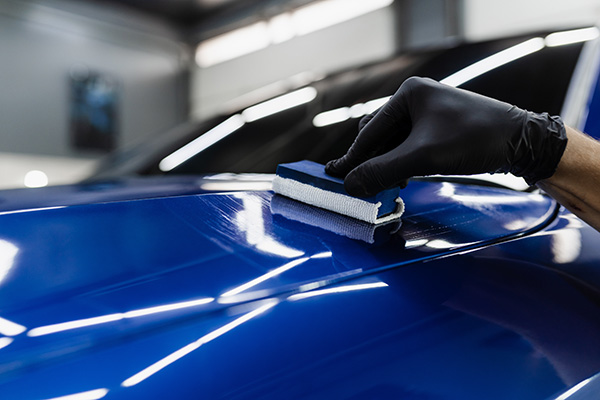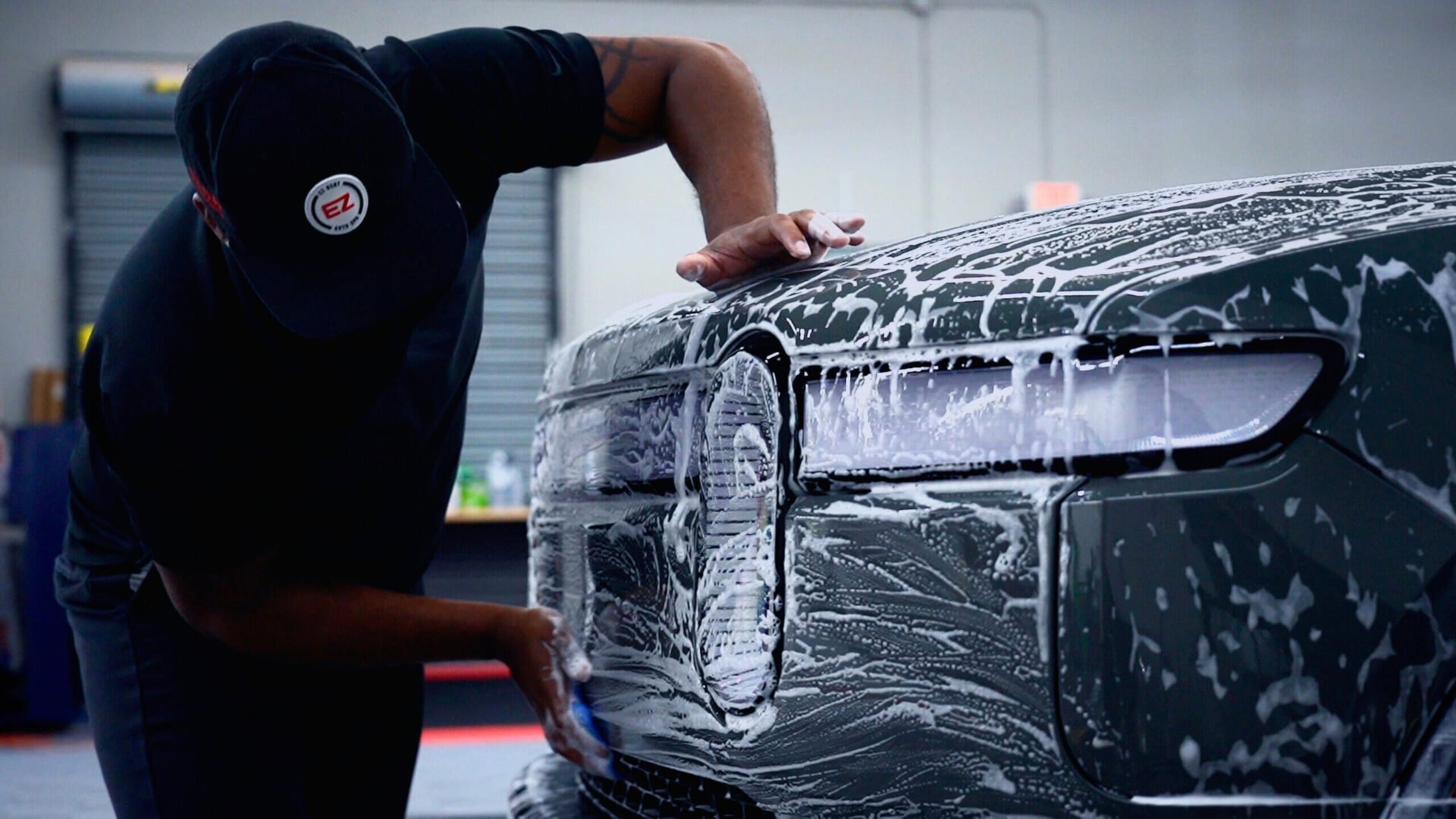The Relevance of Ceramic Coating: Protecting Your Auto's Exterior With Precision
In an age where preserving the useful and aesthetic integrity of your lorry is extremely important, ceramic covering emerges as a pivotal remedy. This safety layer not just guards versus ecological adversities yet also boosts the aesthetic allure of your auto. With its one-of-a-kind bonding buildings, ceramic finish offers a degree of defense that much exceeds conventional waxing techniques. Exactly how precisely does it accomplish such exceptional results? As we discover the nuances of its application and contrast it to various other choices, one can not assist yet wonder about the specifics that make this innovation indispensable for contemporary cars and truck treatment.
Advantages of Ceramic Coating
When it comes to maintaining a car's visual allure, ceramic layer supplies considerable advantages. By forming a semi-permanent bond with the vehicle's paint, ceramic coatings properly protect against oxidation and fading, making sure that the automobile preserves a shiny, showroom-like coating for a prolonged period.
Along with its protective qualities, ceramic covering offers impressive hydrophobic residential or commercial properties, creating water and various other liquids to bead off effortlessly. This feature streamlines the cleansing process, as dust and particles are less most likely to abide by the surface area, decreasing the frequency and effort needed for upkeep. The layer's resistance to chemical spots from acidic impurities like bird droppings and tree sap is another significant benefit, lessening possible paint damage.
Ceramic finishes also improve scrape resistance, offering a layer that can soak up small abrasions and swirl marks. This characteristic is specifically useful in keeping an excellent surface, lowering the chance of visible imperfections and protecting the integrity of the cars and truck's paintwork in time.

Just How Ceramic Finishing Functions
Recognizing the mechanics behind ceramic covering exposes its effectiveness as a safety remedy for cars. Ceramic finishes are basically liquid polymer applications that chemically bond with a car's factory paint, creating a protective layer. This layer works as a barrier against environmental contaminants such as crud, ultraviolet, and dust rays, which can weaken an automobile's exterior in time. The essential part in ceramic layer is silicon dioxide (SiO2), which stems from quartz crystals and is recognized for its phenomenal hardness and sturdiness.
Application of ceramic finish involves a meticulous procedure. The automobile's surface must be extensively cleaned and sanitized to make sure optimal attachment. When applied, the liquid polymer creates a semi-permanent bond with the paint, hardening right into a transparent, sturdy shield. This guard improves the car's gloss and hydrophobic residential or commercial properties, facilitating less complicated cleansing by triggering water and impurities to grain and slide off easily.
In addition, the covering's molecular framework provides resistance to minor scrapes and chemical discolorations. Unlike waxes or sealants that sit on top of the paint, ceramic coatings integrate with the surface area, supplying lasting security. This assimilation is fundamental to its efficiency, ensuring the automobile's coating remains excellent for several years.
Comparing Ceramic Coating to Alternatives
In the world of automotive protection, ceramic finish stands as an awesome alternative when compared to conventional options such as waxes and sealants. While waxes offer a temporary lustrous finish, typically lasting just a couple of weeks to months, ceramic coatings provide a longer-lasting solution, often enduring for several years. This durability is connected to the chemical bonding that takes place when ceramic layers are used, developing a solid layer that is immune to environmental risks.
Contrastingly, sealants, although more resistant than waxes, still drop short of the robust defense used by ceramic finishings. Sealants can usually last for approximately a year, offering a synthetic guard against certain components. They lack the premium hydrophobic buildings and UV defense that ceramic finishings deliver.
Moreover, ceramic coatings offer improved scrape resistance, which neither waxes nor sealants can effectively match (ceramic coating). This is especially helpful in keeping a cars and truck's beautiful look. Additionally, ceramic finishes simplify maintenance initiatives by minimizing the adherence of dirt and gunk, therefore helping with easier cleansing. In summary, while standard waxes and sealers provide fundamental protection, ceramic finishings offer an extensive, lasting solution that considerably maintains the vehicle and improves's outside finish.
Application Process Discussed
Applying ceramic finishing to a car needs a careful procedure to make certain optimum outcomes and longevity. The first step entails extensively cleaning up the cars and truck's surface area to eliminate dirt, home grease, and previous waxes. This is essential for guaranteeing the finishing adheres properly. A pH-neutral hair shampoo and a clay bar therapy are usually made use of to accomplish a beautiful surface. Once cleansed, the lorry is dried out and polished to eliminate any kind of blemishes, as any type of existing scratches or swirls can become much more noticable after the finishing is used.
Following surface area preparation, the application of the ceramic layer begins. The coating is typically applied in a climate-controlled environment to avoid dirt particles from choosing the fresh cleaned up surface. Making use of an applicator pad, the ceramic finishing is used in little areas to ensure also coverage. It is necessary to follow the maker's guidelines pertaining to the suitable healing time go to this site and application thickness.
After application, the finish requires a particular treating duration, throughout which the vehicle must be shielded from water and contaminants. This curing process can differ relying on the product but normally varies from 24 to 2 days. Ultimately, this comprehensive process is essential in attaining a resilient and glossy surface.
Upkeep Tips for Long Life
To maintain the longevity of a ceramic coating, adherence to a disciplined maintenance regimen is crucial. Stay clear of automated automobile washes, as their harsh brushes can compromise the layer's honesty.
Post-wash, drying the car with a clean microfiber towel protects against water areas that see may degrade the coating with time. Additionally, apply a ceramic covering booster every couple of months. These boosters enhance the hydrophobic buildings and boost the finishing's protective capacities, ensuring it continues to be efficient against impurities.
Bear in mind that vehicle parking locations play a critical function in maintenance. ceramic coating. Whenever feasible, park in shaded areas to lessen UV exposure, which can progressively deteriorate the covering. For lasting storage, consider utilizing an automobile cover for added defense against ecological components
Final Thought
To conclude, ceramic finish functions as an important safety layer for vehicle outsides, providing long-lasting protection versus environmental variables such as uv, gunk, and dust rays. By forming a semi-permanent bond with the paint, it improves visual appeal while preserving the auto's value. Its hydrophobic buildings facilitate much easier upkeep, distinguishing it from alternative protective approaches. Understanding the application procedure and sticking to upkeep recommendations are vital for taking full advantage of the durability and performance of ceramic covering.
When it comes to protecting a vehicle's visual charm, ceramic finish supplies considerable advantages. By developing a semi-permanent bond with the car's paint, ceramic finishes properly stop oxidation and fading, guaranteeing that the cars and truck keeps a glossy, showroom-like finish for an extended duration. Ceramic layers are basically liquid polymer applications that chemically bond with an auto's manufacturing facility paint, producing a protective layer. In summary, while conventional waxes and sealants use standard protection, ceramic finishes offer a detailed, long-term solution that dramatically improves and maintains the automobile's exterior coating.
